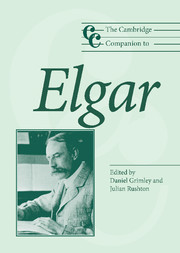Book contents
- Frontmatter
- 1 Introduction
- 2 Elgar and his British contemporaries
- 3 Elgar and his publishers
- 4 Magic by mosaic: some aspects of Elgar's compositional methods
- 5 Elgar's musical language: the shorter instrumental works
- 6 The early choral works
- 7 Elgar's later oratorios: Roman Catholicism, decadence and the Wagnerian dialectic of shame and grace
- 8 Roman Catholicism and being musically English: Elgar's church and organ music
- 9 ‘A smiling with a sigh’: the chamber music and works for strings
- 10 In search of the symphony: orchestral music to 1908
- 11 The later orchestral music (1910–34)
- 12 Elgar's unwumbling: the theatre music
- 13 Elgar and recording
- 14 Broadcasting's ally: Elgar and the BBC
- 15 Elgar in German criticism
- 16 Functional music: imperialism, the Great War, and Elgar as popular composer
- Notes
- Select bibliography
- Index
5 - Elgar's musical language: the shorter instrumental works
Published online by Cambridge University Press: 28 September 2011
- Frontmatter
- 1 Introduction
- 2 Elgar and his British contemporaries
- 3 Elgar and his publishers
- 4 Magic by mosaic: some aspects of Elgar's compositional methods
- 5 Elgar's musical language: the shorter instrumental works
- 6 The early choral works
- 7 Elgar's later oratorios: Roman Catholicism, decadence and the Wagnerian dialectic of shame and grace
- 8 Roman Catholicism and being musically English: Elgar's church and organ music
- 9 ‘A smiling with a sigh’: the chamber music and works for strings
- 10 In search of the symphony: orchestral music to 1908
- 11 The later orchestral music (1910–34)
- 12 Elgar's unwumbling: the theatre music
- 13 Elgar and recording
- 14 Broadcasting's ally: Elgar and the BBC
- 15 Elgar in German criticism
- 16 Functional music: imperialism, the Great War, and Elgar as popular composer
- Notes
- Select bibliography
- Index
Summary
Elgar never received a composition lesson in his life. That may be looked at in two ways. The fact that his father kept a music shop has more often than not been seen as a social disadvantage: being born into trade contributed to the chip on his shoulder, and it certainly bothered his wife. But should not the emphasis rightly be on music shop? For what better environment could the penurious young composer have had than the music, books, and instruments all around him: the shop formed his private library, his laboratory. He learned by listening and doing.
His earliest notated piece, which he wrote down in 1867, is a single line in the bass clef, later used in ‘Fairies and Giants’ in The Wand of Youth Suite No. 1. Already present are two abiding elements of his style: loping compound rhythm, and sequences – of five repetitions in bars 2–4. In the answering phrase the first sequential repeat is modified by an accidental, A# in G major. In 1919 Elgar completed his Cello Concerto. The main theme of the first movement is a single line of three two-bar sequences played by the violas; in the soloist's answering phrase the second repeat is modified by an accidental, C# in E minor. The distance between the ten-year-old and the sixty-two-year-old composer at that moment seems touchingly short.
- Type
- Chapter
- Information
- The Cambridge Companion to Elgar , pp. 50 - 62Publisher: Cambridge University PressPrint publication year: 2005

